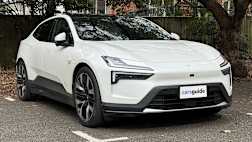Volvo has revealed its first battery-electric vehicle (BEV), a zero-tailpipe-emissions version of its hot-selling XC40 small SUV, which will be in Australian showrooms in the fourth quarter of next year.
Aptly named Recharge P8, the latest XC40 variant rides on the Swedish brand’s familiar CMA platform that was developed from the outset to support fully electric powertrains and underfloor battery packs.
This same architecture underpins the Polestar 2 mid-size sedan from Volvo’s all-electric performance sub-brand, so it comes as no surprise that the XC40 Recharge P8 shares its 300kW/660Nm dual-motor powertrain and 78kWh lithium-ion battery.
As a result, the all-wheel-drive XC40 Recharge P8 can sprint from standstill to 100km/h in 4.9 seconds, while it has a driving range of more than 400km on the WLTP test.
Using a DC fast charger, the XC40 Recharge P8 can – wait for it – recharge its battery from flat to 80 per cent in 40 minutes.
Externally, the Recharge P8 is very similar in design to the regular XC40, save for its closed-off grille, unique 19- and 20-inch alloy wheels, ‘Recharge’ lettering on the C-pillars, and rear ‘Recharge P8’ badge.
Inside, it is also business as usual, but the XC40 Recharge P8 does debut Volvo’s new Android-based infotainment system that fully integrates with its existing digital connected services.
The XC40 Recharge P8 also gets a 30L frunk due to its lack of an internal-combustion engine, while Volvo has promised the move to zero tailpipe emissions has liberated more in-cabin storage.
The marque has also said that the XC40 Recharge P8 comes armed with its next generation of advanced driver-assist systems, although it is still yet to confirm specifics.
“We have said this several times before: for Volvo Cars, the future is electric,” said Volvo Cars president and chief executive officer Hakan Samuelsson.“Today we take a major new step in that direction with the launch of our fully electric XC40 and the Recharge car line.”
Over the next five years, Volvo will launch a new BEV each year as part of its plans to have zero-tailpipe-emissions vehicles account for 50 per cent of its global sales by 2025, with the remainder to be hybrids.
To meet this anticipated demand, the company will triple its production capacity for electrified vehicles, with this move necessary to achieving its short-term goal of having PHEVs account for 20 per cent of its global sales next year.
According to a previous announcement, the XC40 Recharge P8 is scheduled to be made in China by Volvo’s joint venture with Beijing Automotive Industry Holding Company (BAIC).
Naturally, the Recharge branding will be applied to all of Volvo’s future BEVs, but it will also be used for its existing and forthcoming plug-in hybrids (PHEVs), which are currently offered across all of its global model lines.
In Australia, the last piece of the PHEV puzzle will be the XC40 T5 Twin Engine, which is set to join the small SUV’s line-up around the same time as the Recharge P8.
Local pricing and specification details for the XC40’s new Recharge P8 and T5 Twin Engine variants will be announced closer to their respective launch dates.





.jpg)
.jpg)

.jpg)
_0.jpg)


.jpg)














.jpg)
.jpg)







